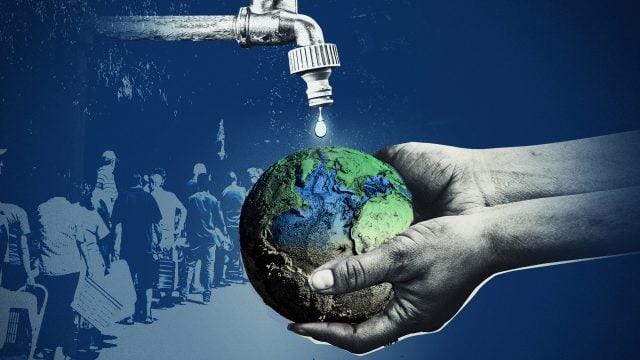
By Sohail Hyderi
Climate change and water scarcity are two interconnected issues that pose a looming crisis for our planet. As the temperature of the earth continues to rise due to emissions of greenhouse gases, we are witnessing extreme shifts in weather patterns and it is causing depletion in water resources by causing melting of glaciers and increasing sea level which then increases the chances of flood and other disasters.
Climate change and water scarcity are two interconnected issues that pose a looming crisis for our planet. As the temperature of the earth continues to rise due to emissions of greenhouse gases, we are witnessing extreme shifts in weather patterns and it is causing depletion in water resources by causing melting of glaciers and increasing sea level which then increases the chances of flood and other disasters.
The increase in temperature is a dangerous effect of climate change. Prolonged droughts and reduced snowfall in mountainous areas directly impact the availability of water. This leads to a decrease in the water supply for agriculture, drinking, and sanitation purposes. In particularly vulnerable regions, such as arid and semi-arid areas, water scarcity becomes a significant challenge that affects food security and human well-being.
Agriculture is a field that consumes large amount of water but climate change is directly impacting crop production. Climate change is causing changes in patterns of rainfall. There will be more rainfall when it’s not needed and there will be no rainfall when it is most needed for agriculture. Heavier and more erratic rainfall can result in soil erosion, decreased crop yield, and increased water runoff. Additionally, temperature rise contributes to increased evaporation rates, reducing the amount of water available for irrigation. These factors not only threaten food production but also the livelihoods of millions of farmers worldwide
Water scarcity not only affects human populations but also ecosystems. The decrease in freshwater availability puts unique habitats at risk, affecting biodiversity and leading to the loss of various species. Rivers, lakes, and wetlands, which are vital for numerous plant and animal species, are under stress as water becomes limited. Aquatic ecosystems suffer from pollution, habitat destruction, and a decline in the presence of aquatic creatures, all due to water scarcity caused by climate change.
Addressing climate change and water scarcity requires a multi-faceted approach. Mitigating greenhouse gas emissions through the adoption of renewable energy sources, promoting sustainable agriculture practices, and enhancing water conservation strategies must be part of the solution. Implementing efficient irrigation systems, minimizing water wastage, and investing in technologies for water management are essential steps.
International cooperation can play a vital role in combating climate change by developing equitable and sustainable strategies. Collaborative efforts between governments, private sector entities, and civil society organizations can help improve access to clean water, enhance water management practices, and mitigate the effects of climate change on water resources. People should be informed about climate change and its effects by using different platforms like social media, broadcast media, etc. People can be trained to combat this crisis by arranging seminars and training sessions. Some experts should be made leaders so that they can easily convince people to this action.

In conclusion, climate change is becoming dangerous day by day for human beings and all other ecosystems because there is no life without water, and climate change is causing the depletion of water resources. So we should make some policies to save water for our life and also for the future generations of our mother planet ‘Earth’.
_________________________
The author is a student of Media and Communication department at the University of Punjab.

